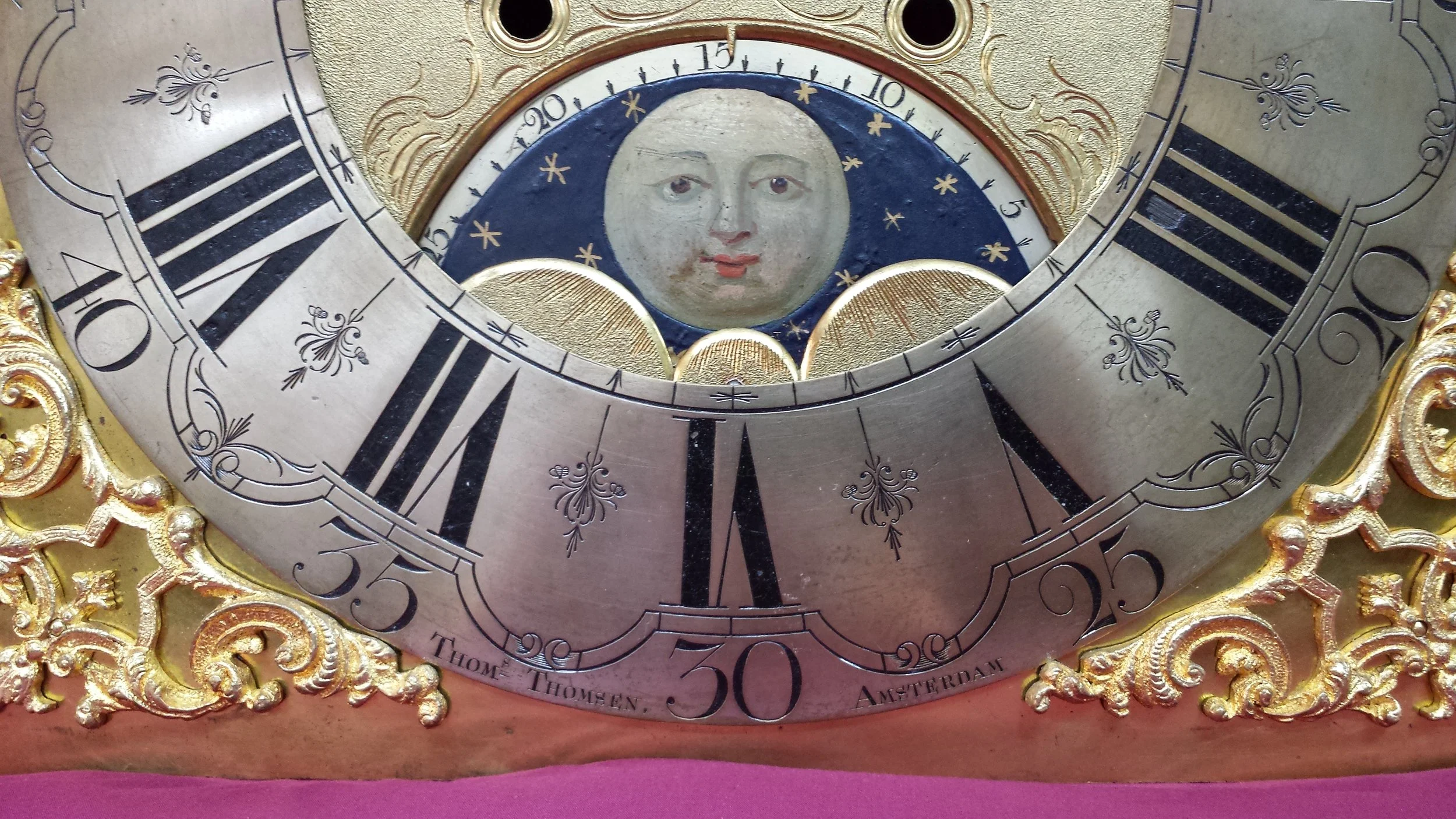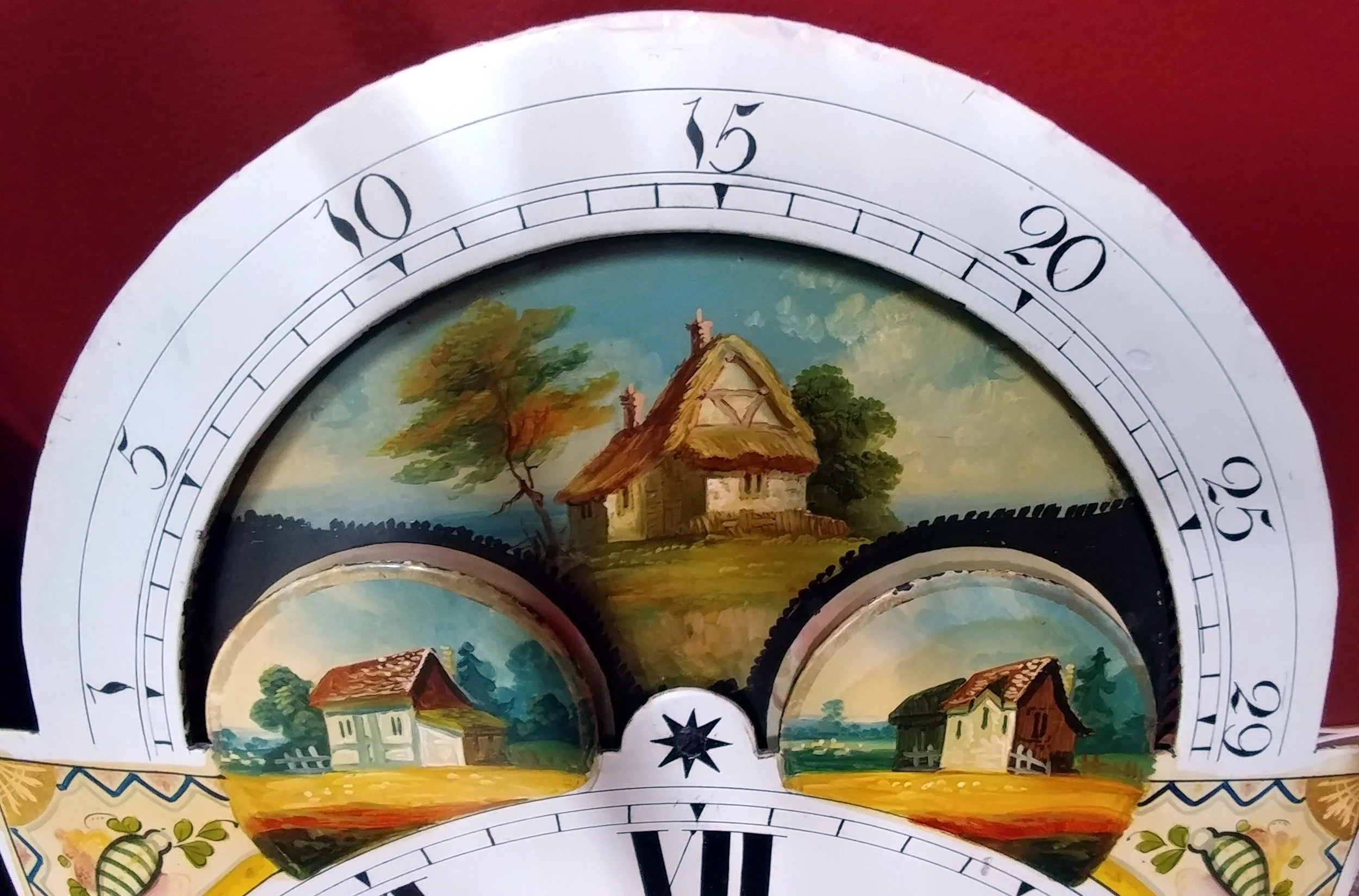
How To Set A Moon Dial
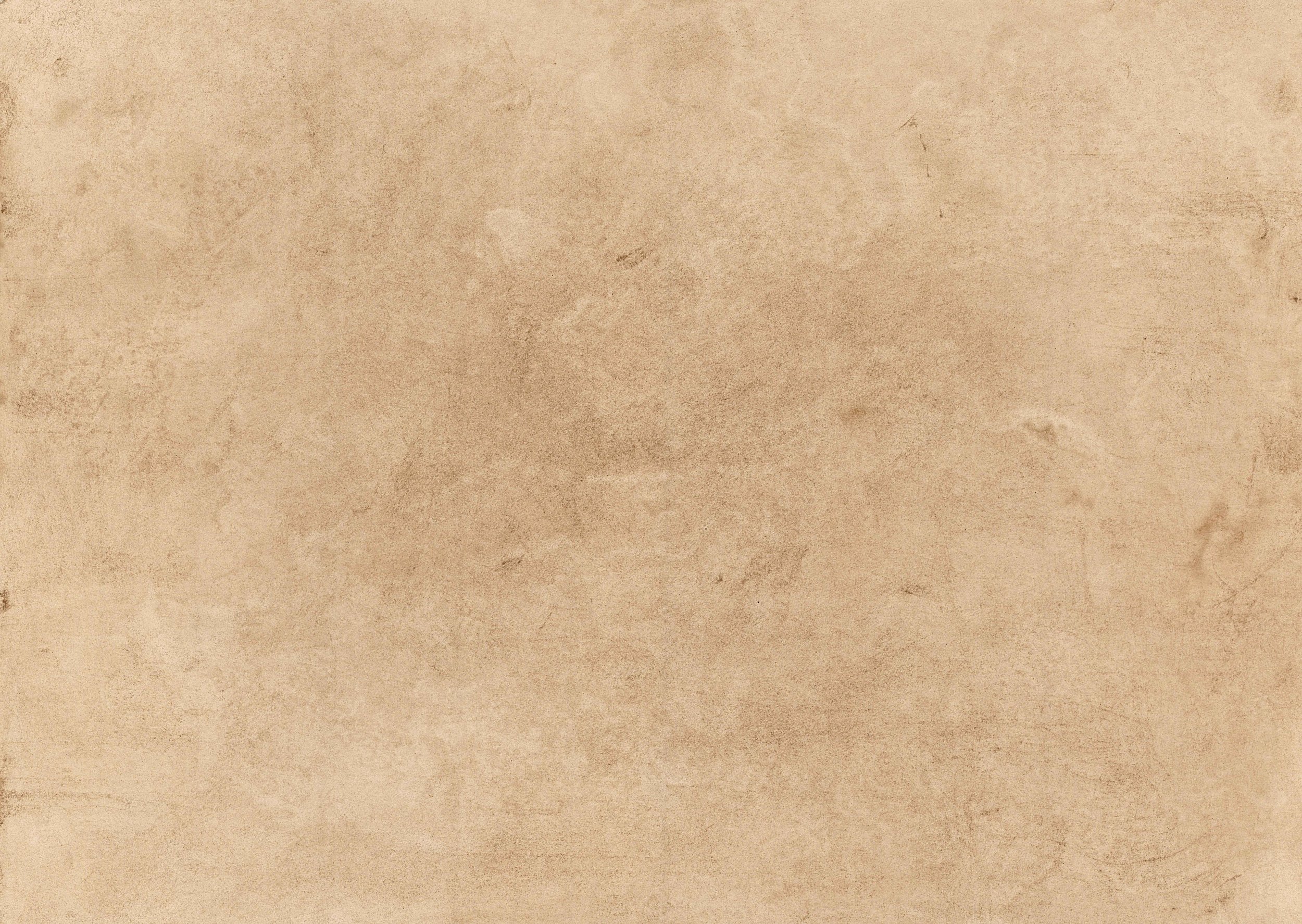
History and Use
What’s it for anyway?
Before we tackle how to set the moon dial it might help if you are aware of its purpose, tradition and history. After reading the wealth of information below you will be able to impress your friends and neighbors with how knowledgeable you are when they ask you what that thing is on the top of your clock. If you are not interested in this information, you can scroll down to “INSTRUCTIONS FOR SETTING” below.
The moon dial or lunar phase dial is not of any practical use to most of us in our modern era. It’s place on current production grandfather clocks is more out of a sense of tradition than anything else. From a manufacturer’s standpoint it is not much more than a talking point when selling a clock. In other words, it is another feature like raised brass numerals, beveled glass or a cable driven movement that enhances a clock’s value.
the moon dial exists in conjunction with timekeeping devices (grandfather clocks most frequently) simply because the passing of the moon is easily relatable mathematically to the passing of time, minutes, hours and days. Our concept of dividing time is based on the length of time it takes for the earth to travel around the sun. The month, week, day, hour and minute are simply smaller and smaller divisions of that amount of time. The work of most clocks is to simply keep track of the hour and minute. Others add a second hand and still others will tell us the day of the month. Those that do tell us the day of the month rarely take into account the differing lengths of our months and have to be reset manually to compensate for this.
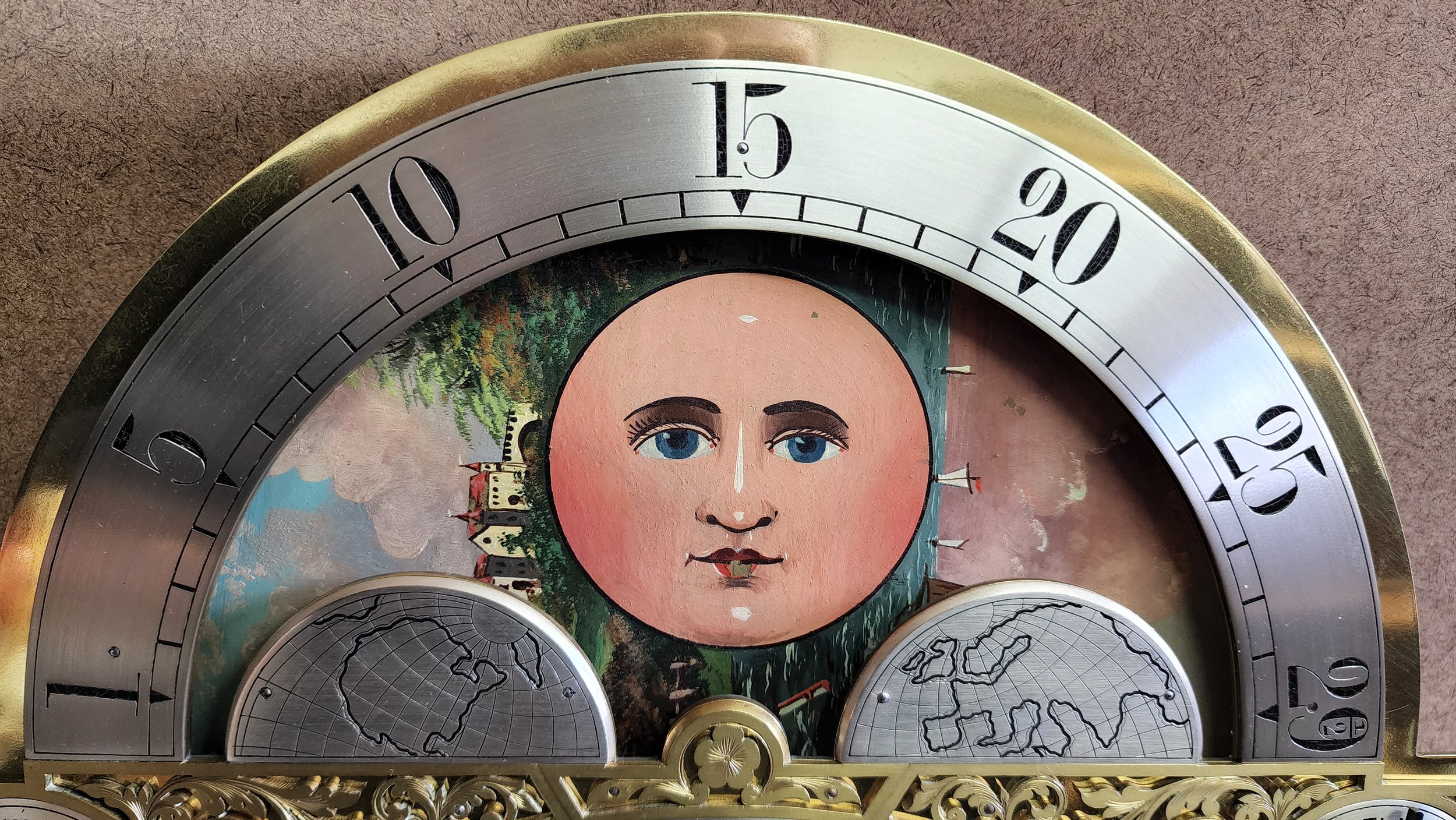
Hand Painted Moon Dial Showing Full Moon

Perpetual Calendar and Astronomical Clocks
If you want a clock that does compensate for the inconsistent number of days in our months, in the era around 1900 they were mass producing what were called “perpetual calendars”. These clocks were quite complex as they had the ability to account for the different length of our months and also, believe it or not, account for the 29 days in February during the leap year.
If a perpetual calendar on your clock is not enough for you, they get more complex still. There are some time pieces called Astronomical Clocks that were designed to show us the movement of all the planets in relationship to the sun.
This takes us back to our original subject; since it is possible for a clock to give us all this very complex information why not have the clock show us something less complex; the phase of the moon?
Perpetual calendar Clock Shown on left at top with close up photo of calendar dial bottom left.
Astronomical Clock at top right shows movement off all the planets. Clock at bottom right shows rotation of moon around earth and earth around sun.
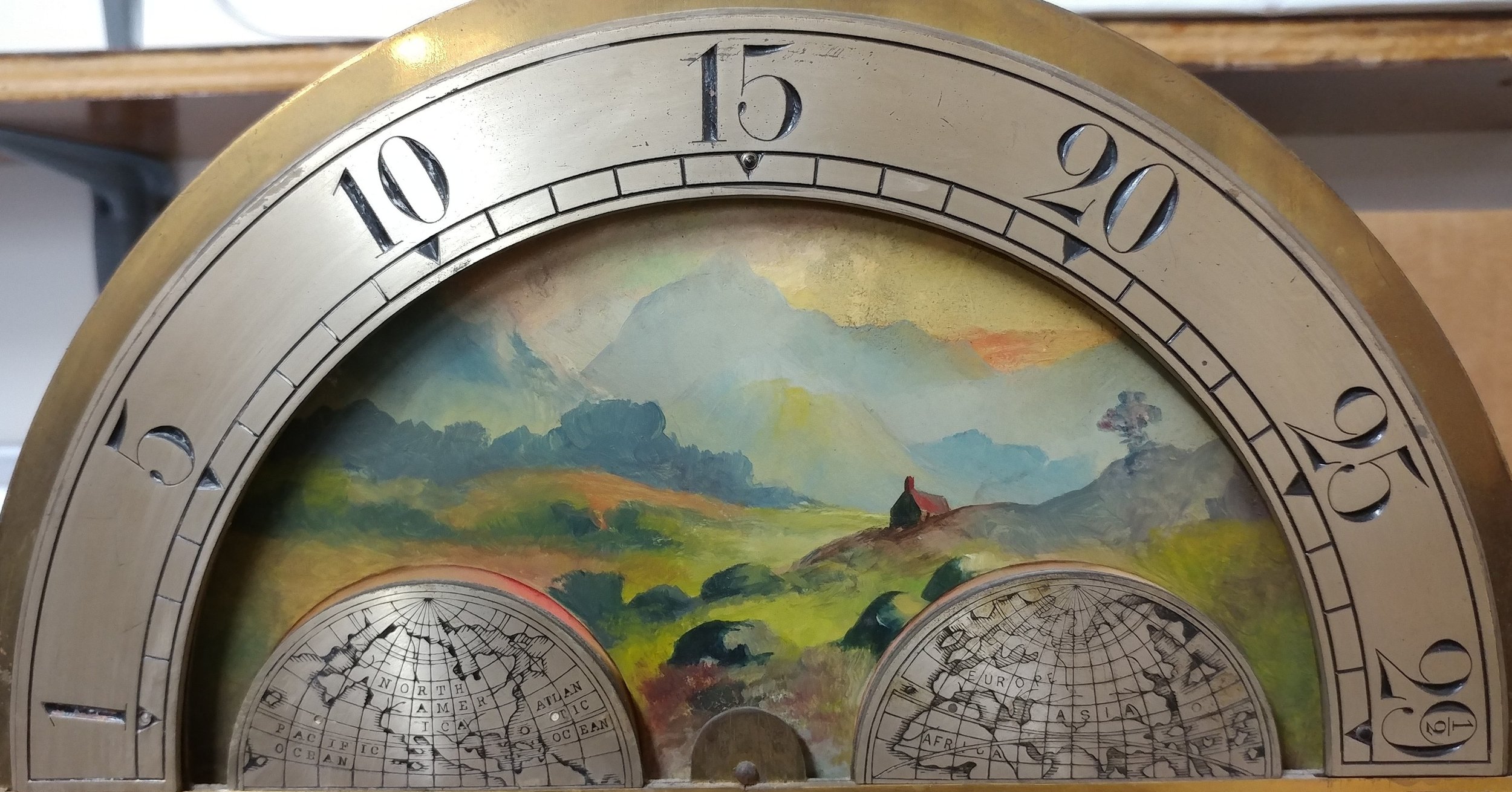
Moon Dial showing Landscape and two hemispheres

Tradition
You might be thinking, “Who cares, why bother?” First of all, it is a fairly easy procedure to add this function to a clock, even easier than designing a clock to tell us the day of the month. The lunar month is always the same length, 29 ½ days, whereas the calendar month, as mentioned earlier, is not always the same. Secondly, in times past the moon dial did provide needed information. There was a time when knowing the phase of the moon was very important, especially to farmers. Before the industrial revolution when almost all economies were agriculturally based big farmers were some of the wealthiest of individuals and able to afford clocks which were very expensive at the time. The farmer knew that when the moon was full or nearly full there would be more light in the evening to allow working the fields later than normal. Also there was a particular tradition based on the movement of the moon around the earth and its effect on the earth about when to plant certain crops. Crops that grew above ground like corn and wheat were to be planted in the light of the moon where as crops that grew below ground like potatoes and carrots were to be planted in the dark of the moon. In summation, farmers could afford clocks and they wanted to know what the moon was doing. Back in those days you did not go to the local clock retail store and buy a clock, you went to the local clockmaker and paid him to make one for you. It is reasonable to assume that a farmer, knowing it was possible, might ask the clockmaker to be sure to put a moon dial on his clock. It is in looking back on the history of the moon dial that we find the purpose of its presence on our modern clocks; that purpose is tradition.
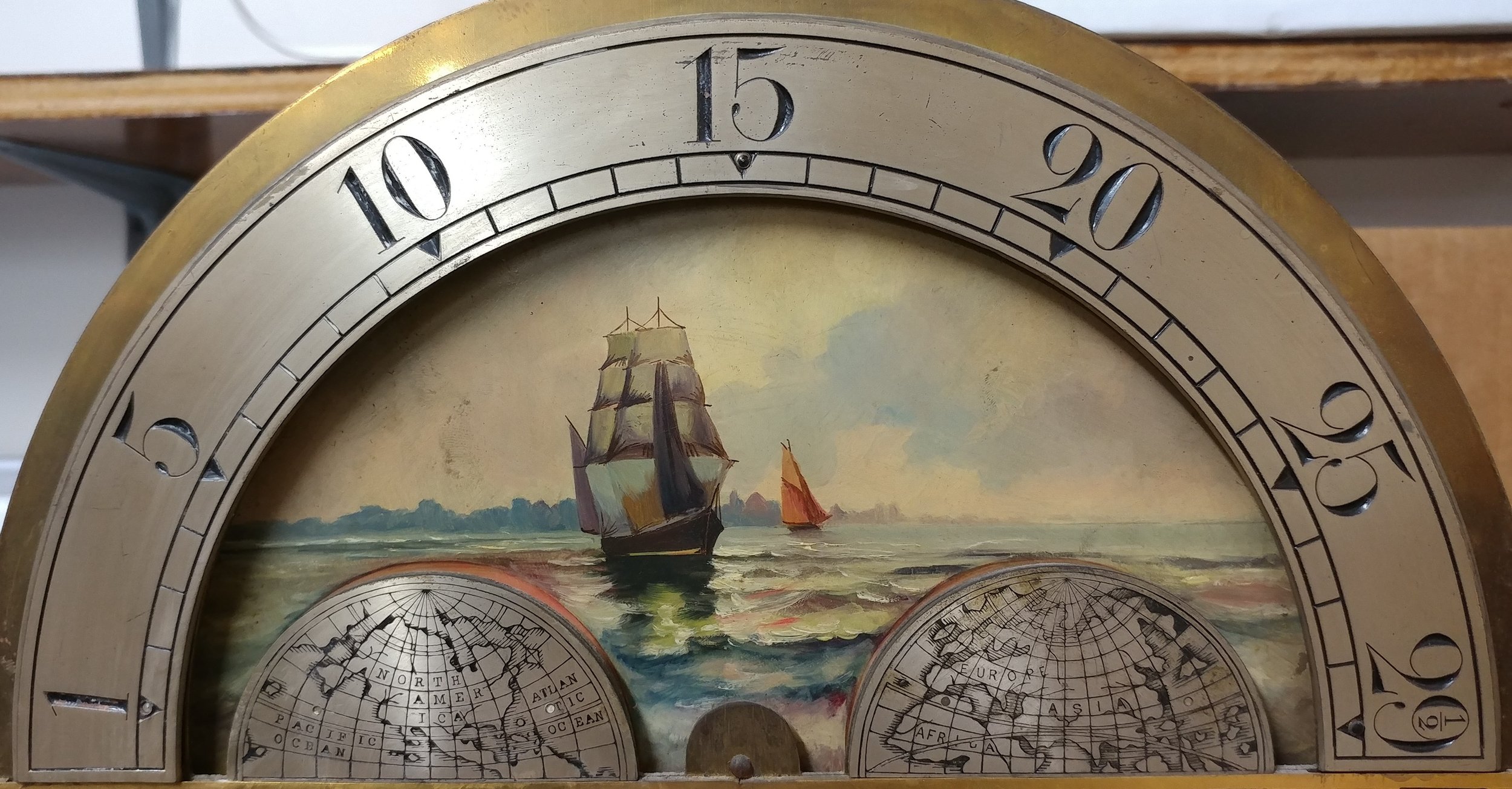
Moon Dial showing Seascape

Examining The Moon Dial
It is helpful to know what you are looking at when viewing a moon dial. The first things we typically notice are the pictures of the moon on the dial itself. First of all, there are two moons (see photo on left below). This is necessary because the dial only rotates half the way around it’s circumference to simulate one set of moon phases, or one lunar cycle. When one moon disappears on the right side on day 29 ½ there has to be the other moon ready to pop up on day one on the left side of the scale. The moon dial has other pictures on it as well. Traditionally there are two; a seascape and a landscape (see below, left and right). These pictures simply give us something to look at when the moon is either just appearing or almost disappearing.
Next thing we notice is the scale along the top with the numbers on it. (See photo above) Usually we see a 5, 10, 15, 20, 25 and 29 ½. These numbers are not calendar dates as is often supposed but are lunar dates instead. What is the difference? The difference is that lunar dates and calendar dates do not coincide except by chance.
the numbers on the scale allow us to tell the lunar date. On most floor clocks we do this by drawing an imaginary line from the supporting nut, bolt or rivet at the dial’s center, between the hemispheres, through the center of the moon, to point at the scale. In the picture of the moon dial above center, this imaginary line is pointing at the seven on the scale. This means it is the seventh day of the Lunar Month. If you look at the photo of the moon dial below, you will see that the artist that painted the moon’s face also painted a little pointer on the top of his head. This pointer takes the place of the imaginary line. Using the pointer, you can see that it is pointing to the center of the scale where the number fifteen is. You can also see that the moon dial indicates a full moon. Therefore, the full moon always lands on the fifteenth day of the lunar month.
The last thing to examine are the two half circles that look like portions of the globe. (See photo below) These are called hemispheres. Usually, these hemispheres will picture Europe, Africa and Asia on the right side and the Americas on the other. The purpose of these hemispheres, (portions of the earth) is to simulate the real effect, created by the shadow the earth casts on the moon, that creates the crescent moon effect.
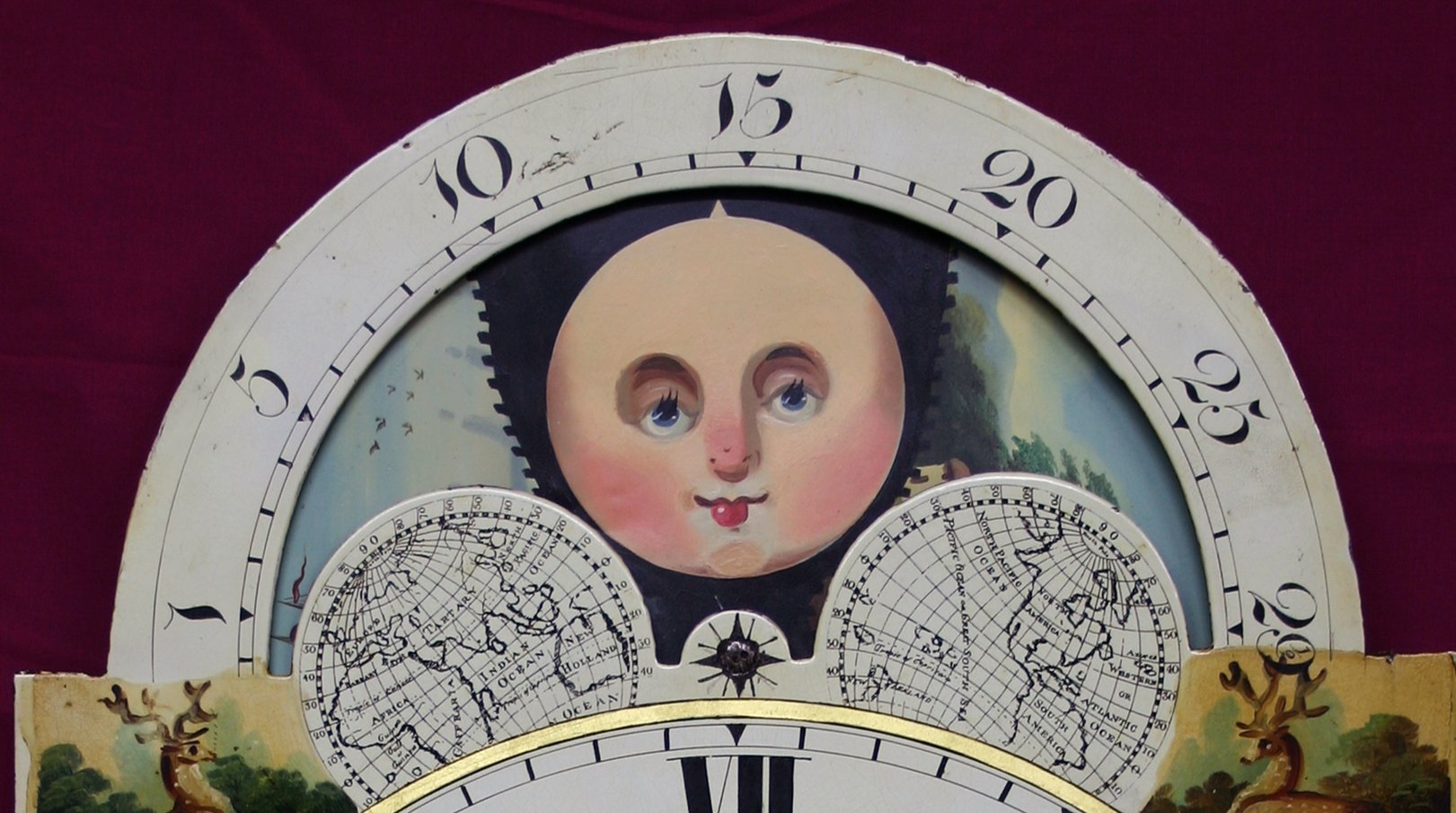
Hand Painted Moon Dial with pointer on moon’s head

Some people mistakenly think that the pictures are predicting the weather. I have had several customers tell me this. They thought that when the seascape was showing it was going to rain! Other people think that the moon is really a sun and that the “sun” should be visible during the day and disappear at night. This is wrong as well. The picture of the moon only advances a small distance each day. Remember that a moon month takes 29 ½ days, therefore it takes the moon picture the same length of time to travel across the simulated “sky” of our moon dial.
Misconceptions about the moon dial
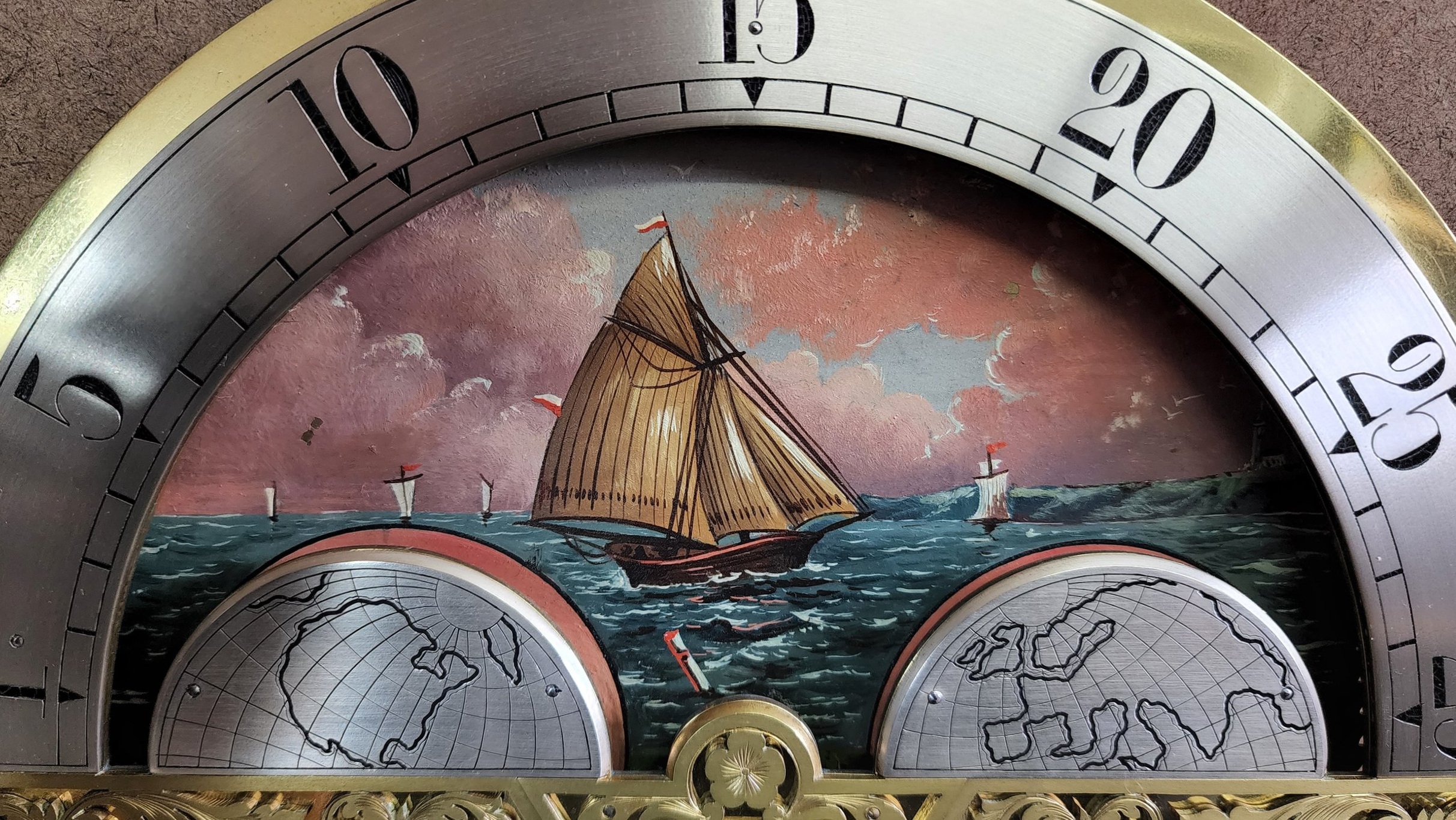
Hand Painted Moon Dial with Seascape

Instructions For Setting
looking at the Actual Moon
The easiest way is to simply go outside on a clear night and look at the moon. The best time is when the moon is full. Have you ever been driving home at night when someone in the car says, “Look, it’s a full moon tonight”? Next time you hear someone say it or you notice it yourself, when you get inside the house, set your dial so that the moon is in the center and completely visible.
Using the Internet
There are websites that will tell you the phase of the moon for any given day. My favorite is “moonconnection.com”.
Using the website on moonconnection.com, the calendar will show you the phase of the moon for every day of the month. Simply turn the moon dial so that the moon represents the size of the moon in the picture on the calendar. Alternatively, you may see today’s lunar date next to today’s calendar date. Once you know today’s lunar date you can use the scale in the arch above the moon to set the moon to the correct position. As mentioned previously, draw an imaginary line from the center, between the two hemispheres, through the center of the moon, and make that line, line up with the lunar date on the arch. (See instructions below on how to physically move the moon dial) If the moon is getting larger each day, it is called a “waxing” moon and it will appear on the left half of the moon dial. if the moon is getting smaller each day, the moon is “waning”, and it will be on the right side of the moon dial.
Using a calendar or the newspapers weather page
Another way to do this is to use the information you can find on many of the larger calendars or on the weather page of most newspapers. I am sure many of you have seen this before but ignored it. On each month’s page, you will notice small pictures of four different little moons, one picture of each of the four different phases. Sometimes these moons appear together at the top or bottom of the page (with little numbers below or beside them) and other times they appear on specific dates of the calendar. If there are individual moons on specific days the calendar is telling you that on that date, this is what the moon will look like. If they are grouped together (much like the way they would appear in a newspaper) the number below or beside them is telling you what day of the month that particular moon phase will fall on. With this information you can set the moon dial in the same manner previously described.

Photo below showing the four main moon phases
Photo Below shows image from newspaper

Moving The Moon Dial
Now we have the question, “How do I actually move or advance the dial”. In most cases you can simply touch the exposed part of the dial with your finger and with a little pressure you are able to move the dial forward. If you want to avoid touching the dial directly with your finger, especially if your finger is dirty, oily or sweaty or the moon disc is brass, you can use something else to touch the dial instead of your finger. Ideally something that is not slick, like one of those rubber fingertip “thingies” people use when they are flipping through many pages of paper. Another way is to remove the side panel from your clock, if you have one, or remove the hood if it is removable, and advance the dial from the rear by simply putting your finger on the dial teeth and rotating it forward. Use the picture below as a reference. From this position you do not have to touch the portion of the dial that is visible from the front so there is no fear of smearing something from your finger across the dial or causing it to tarnish.
Sometimes when you attempt to move the moon dial it will appear stuck. Usually when this occurs it means the clock is in the process of advancing the dial. In this case it is important not to force it. You will either need to move the hands several hours or wait several hours until the advancing pin is clear of the dial teeth.
In closing it is necessary to be aware of the index spring that lies up against the side of the moon dial teeth. (See photo below) From looking at the dial examples in the pictures above and below you can see the moon dial looks like a circular saw blade. The index spring lies against these teeth and helps to control how far the dial will advance. Sometimes when setting the dial, the moon dial will get pushed in or out in a way that enables the index spring to get wedged between the back of the clock dial and the front of the moon dial or the spring falls behind the moon dial. If this occurs, you will no longer hear the clicking sound as you advance it, and you will feel a significant drag or scraping sound as it turns. To solve this issue, you need to flex or pull gently on the index spring to move it back into a position so that it lies against the outer edge of the teeth of the moon dial. This index spring is visible in the picture above. It is the brass piece just to the right of the lower half of the moon dial, which from the rear view, has no moons on it.
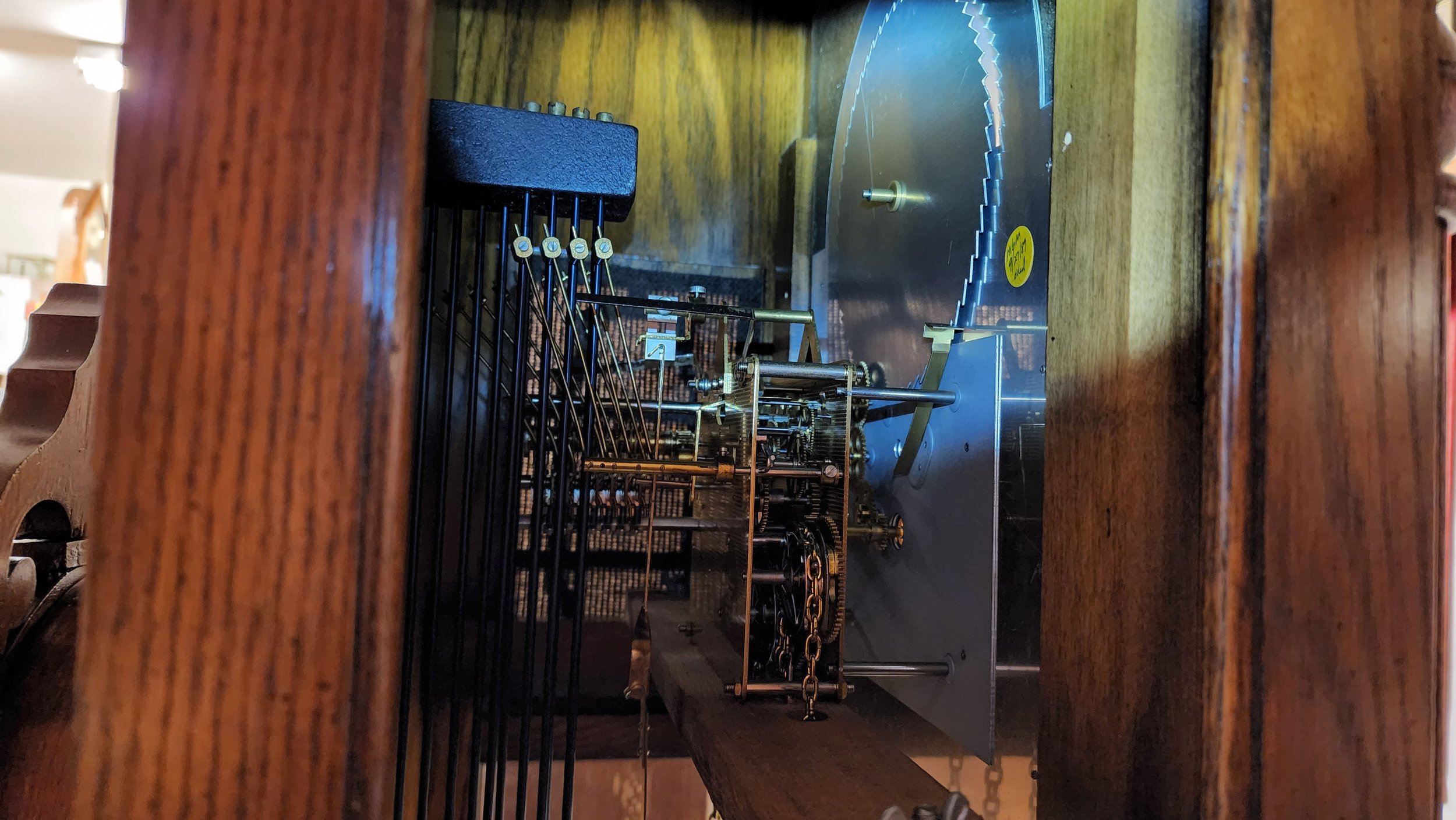
Photo of moon dial from rear of clock dial

Below is a close-up view of the back side of a modern moon dial. The moon dial is the round silver disc with the angled teeth on it. The brass gears are the gears that connect the moon dial on the rear of the clock face to the moon dial gear mounted on the hour hand shaft.
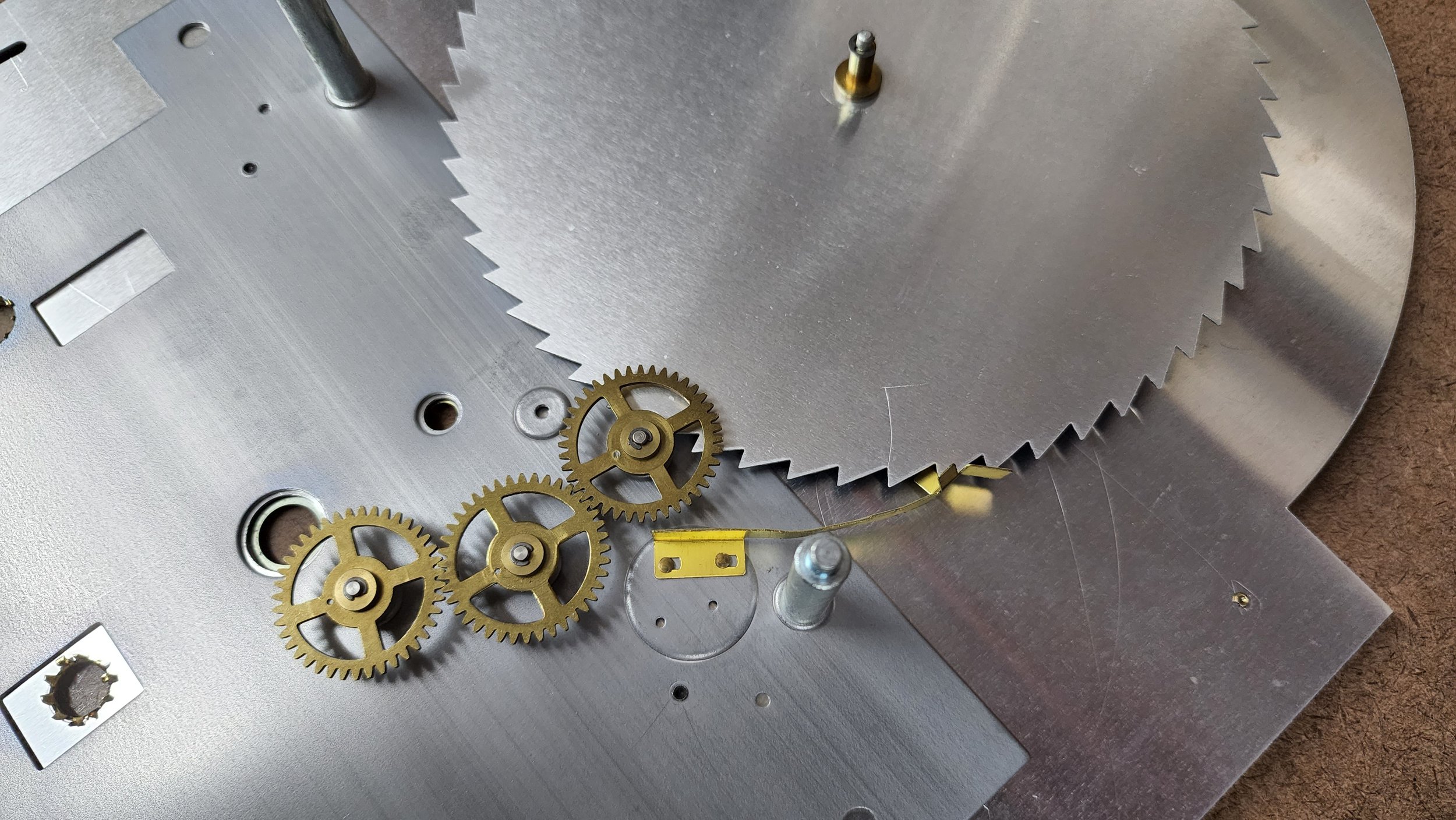
Slide Show of Moon Dial Art
















